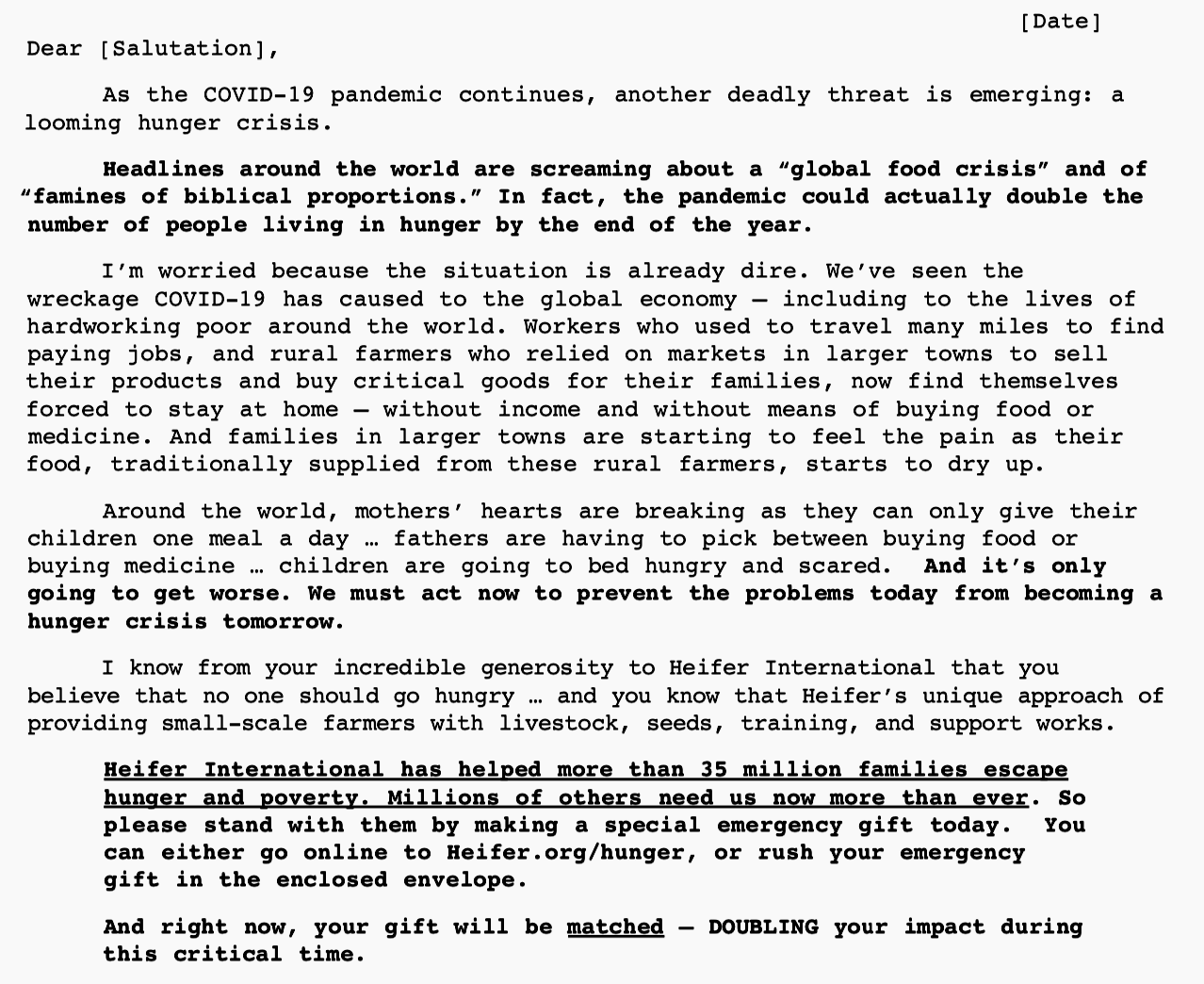Telling Your Donors You Care in the Time of COVID (while still asking for a gift)!
In the early days of the stay-at-home orders, my inbox and mailbox were filled with love. Friends, family and even companies and nonprofits reached out to connect. In those early days, there were more questions than answers and someone saying “I’m thinking about you” made a difference.
Soon after, or simultaneously, nonprofits were also asking for money. The pandemic dramatically increased the strain on many nonprofits to fulfill their mission — whether it was figuring out how a closed museum could still inspire and engage with donors and visitors, or stretching funds at a Meals on Wheels group to feed and serve more and more people in need — nonprofits needed contributions.
Some nonprofit groups managed the balance of stewardship and solicitation beautifully. They sent heartfelt messages of care followed by authentic requests to fill a need.
A few stood out, like Heifer International that sent a personal note from the president that thanked people for continuing to fight hunger and poverty around the world, while they themselves were impacted by the pandemic.

This heartfelt message was followed soon on by a fundraising mailing that authentically explained why Heifer needed additional contributions during this time.

Or, like the Human Rights Campaign that sent members and supporters an email care package — artfully comprised of recipes, songs, and messages of hope from the HRC family.

The “Care Package” was follwed by a fundraising campaign you may have read about in the Chronicle of Philanthropy, where HRC asked members to support a very special campaign that would provide PPE to people in the community.

I include these examples because the time is now to think about the balance of stewardship and solicitation in your own program that is going to be needed over the next few months.
The pandemic is far from over, and the impacts are being felt in a shaky economy. Why, you may ask, is the economy so important in fundraising? Well, when you look at Giving USA reports, you will see that — historically — philanthropy is consistently about 2% of GDP.

And the 2020 GDP projection – from Morgan Stanley – is that real GDP will contract 5.5% in 2020.

A contracting economy means donors will likely be choosing to give to fewer organizations. You want to be the organization that comes to mind first, that has the best fundraising messages out there and that people LOVE.
So, what can you do? Here are a few ideas:
Be Honest About What You Love About Your Donors
Ask yourself: Why do our donors choose to give to us? What do our donors really want to see us accomplish?
Sometimes the easy way to answer these questions is to think about what makes you passionate about the work you do. Then, design stewardship moments that honor that relationship.
For example, if your donors love the fact that you help people — give them those stories. If donors love the leadership or your president — film a “thank you” message video. Think about creating a unique stewardship moment and distribute it in every channel. Timing-wise, thank and steward early and often so that you remain front-of-mind to your donors.
Be Honest About the Work You Are Doing RIGHT NOW
Think about how your work has evolved in the last six months: Have you increased services? Moved to remote programming? Cancelled fundraising events?
Write down what you really need from donors. Then, craft your fundraising messages around that authentic need.
It’s not enough to take a control letter and add, “And, in this time of COVID, your help is needed more than ever.” What is going to stand out this year are the organizations who tell donors why.
Thank Promptly
This is the moment to be painfully honest about your acknowledgement process. If it is slow, or impersonal, or only in one channel, your donors are not going to feel appreciated. And, since they are making hard choices about which nonprofits to support — yours will not make the cut if you do not acknowledge promptly, in all channels and authentically.
So, think about new ways to say, “thank you” and do so — often.
Let me close by following a bit of our own advice and say, I hope you are doing okay in these difficult days. I hope that you and your family are healthy, and that you are finding new ways to do your job.
Let us know if you ever have any questions, and take care of yourself — it is only in doing so that you will be able to take care of your donors.
eNews Signup
If you enjoyed this article and are interested in being notified about future ones, please enter your email address
